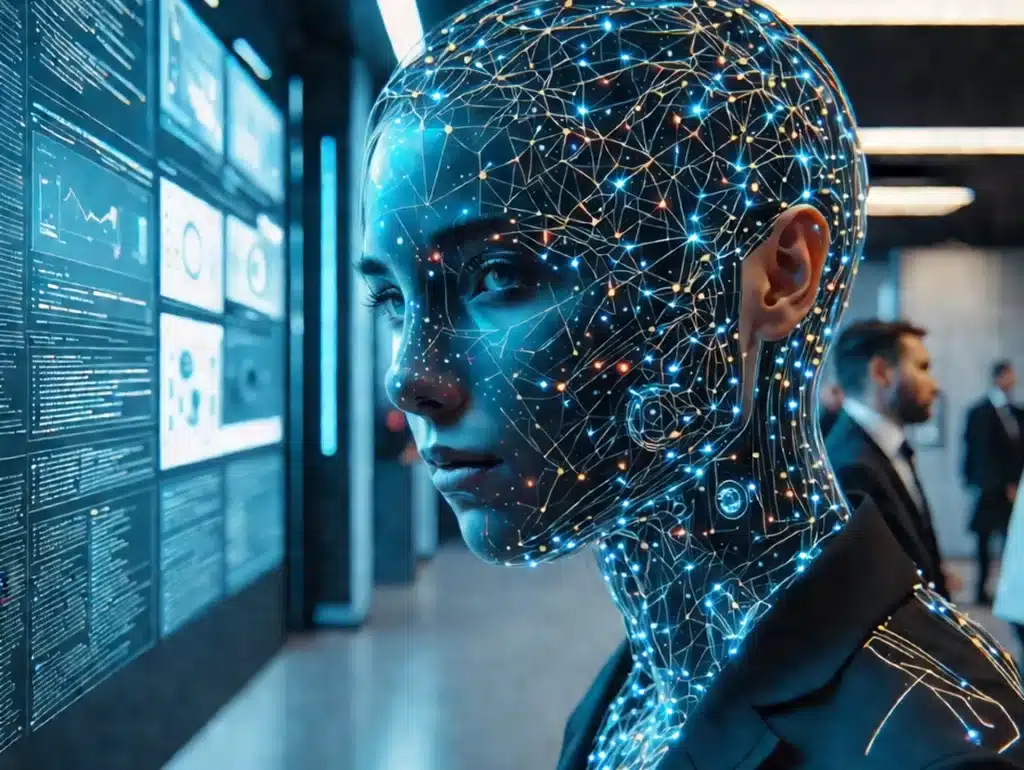Deep learning has emerged as a groundbreaking technology that is revolutionizing various industries. Deep learning enables machines to learn and make intelligent decisions like humans. Deep learning offers a multitude of benefits that reshape the way we work and live. In this article, we take a closer look at the concept of deep learning. We outline deep learning’s mechanics, key benefits, applications, and its future potential.
Understanding Deep Learning
Deep learning is a subset of machine learning. Deep learning focuses on building and training neural networks to mimic the human brain. These neural networks consist of layers of interconnected artificial neurons. The artificial neurons process data and learn from it. Through a process called backpropagation, deep learning algorithms analyze large volumes of data. They then identify patterns, and make predictions or decisions. This ability to learn from data without being programmed makes deep learning powerful. Deep learning algorithms mimic the human brain’s structure and processes. Deep learning algorithms can process and understand data in ways that were once thought to be exclusive to human intelligence.
The Concept of Deep Learning
Deep learning is all about building and training neural networks that can learn from data. These networks consist of layers of artificial neurons, each connected to the next layer. The connections between neurons are weighted. This enables the network to assign importance to different features of the input data. As the network processes data, it adjusts these weights through backpropagation. Backpropagation fine-tunes the network’s performance.
For example, a deep learning model can be trained to recognize images of cats. The model would be fed thousands of images of cats. Through backpropagation, it would learn to identify the unique features that make up a cat. As the model continues to process more cat images, its accuracy and ability to recognize cats would improve.
The Evolution of Deep Learning
Deep learning has come a long way since its inception. In the past, AI systems were limited to performing specific tasks and required extensive human intervention. With advancements in computing power and the availability of vast amounts of data, deep learning has soared to new heights.
Deep learning algorithms can now handle complex tasks that were once thought to be impossible. For example, image and speech recognition have reached unprecedented levels of accuracy. Computers can now identify objects in images. Computers can also transcribe spoken words with remarkable precision.
Natural language processing is another area where deep learning has made significant strides. Algorithms can now understand and generate human language. This enables applications like virtual assistants and language translation systems. These advancements have reshaped the way we interact with technology. They have also created new possibilities for communication and collaboration.
Autonomous driving is another field where deep learning has made great strides. Self-driving cars rely on deep learning algorithms. The algorithms process large volumes of sensor data and make split-second decisions. The algorithms can detect and interpret road signs. The algorithms can recognize pedestrians and other vehicles, and navigate complex traffic scenarios.
As deep learning continues to evolve, its applications are expanding across various industries. Deep learning is transforming the way we live and work. The ability to analyze and understand complex datasets can revolutionize fields like drug discovery, financial forecasting, and personalized marketing.
Deep learning is a powerful and evolving field that has the potential to reshape our world. Through building and training neural networks, researchers are unlocking new possibilities in artificial intelligence. As we continue to push the boundaries of deep learning, we can expect even more exciting advancements and applications in the future.
The Mechanics of Deep Learning
Deep learning is a subfield of machine learning that focuses on the development and application of neural networks. Neural networks are the backbone of deep learning. Neural networks are responsible for processing and manipulating data to generate meaningful outputs. The networks consist of interconnected layers of artificial neurons. The artificial neurons work together to extract intricate features and make complex decisions.
One key characteristic of deep learning is the depth of these neural networks. The term “deep” refers to the multiple layers that make up the network. The depth enables the neural network to learn and understand data at different levels of abstraction. This enables the neural network to capture intricate patterns and relationships. Neural networks continuously refine and optimize connections between neurons. Neural networks improve their performance over time. This leads to more accurate predictions and better decision-making abilities.
Neural Networks and Their Role
Neural networks play a vital role in deep learning by mimicking the structure and functionality of the human brain. Neural networks are sophisticated computational models. Neural networks consist of interconnected layers of artificial neurons. Each neuron in a layer receives input from multiple neurons in the previous layer. The neuron then performs a mathematical operation on this input, and passes the result to the next layer. This process continues through the network until the final layer generates an output. Through training, neural networks can adjust the weights and biases of their connections based on input data and desired outputs. This iterative process enables the network to learn from examples and improve its performance over time. Neural networks are powerful tools for tackling complex problems in various fields. These include image and speech recognition to natural language processing and beyond.
Algorithms Used in Deep Learning
Deep Learning Algorithms
Deep learning relies on a range of algorithms to train and optimize neural networks. Each algorithm is designed to address different types of data and tasks. The algorithms form the foundation of deep learning. They provide the tools and techniques necessary to train and optimize neural networks. These algorithms include:
- Convolutional Neural Networks (CNNs): CNNs excel in image classification and object detection tasks. CNNs automatically learn to extract relevant features from images. CNNs are particularly effective in recognizing objects in photos and identifying patterns in medical images. CNNs are invaluable in fields like computer vision and medical diagnostics.
- Recurrent Neural Networks (RNNs): RNNs are ideal for sequential data processing. This includes natural language processing and time series analysis. RNNs can capture temporal dependencies, enabling them to understand and generate sequences of data. RNNs are particularly useful in applications like language translation, speech recognition, and financial forecasting.
- Generative Adversarial Networks (GANs): GANs consist of two competing neural networks: a generator and a discriminator. The generator learns to create realistic data. The discriminator learns to distinguish between real and fake data. This adversarial process results in the generation of highly realistic synthetic data. GANs have been successfully used in generating realistic images, video game levels, and creating music.
Key Benefits of Deep Learning
Enhanced Data Processing
Deep learning algorithms excel at processing and analyzing large volumes of data. This is particularly valuable in industries such as healthcare and finance. These industries generate vast amounts of complex data that need to be processed quickly, and accurately. Deep learning can efficiently handle big data. This ability enables organizations to uncover valuable insights, identify patterns, and make data-driven decisions.
Improved Accuracy in Predictions
Deep learning models can capture intricate nuances that may go unnoticed by traditional methods. Whether it’s predicting customer behavior, forecasting market trends, or diagnosing diseases, deep learning consistently outperforms conventional methods, providing precise and reliable predictions.
Deep Learning in Various Industries
Healthcare
Deep learning is making significant strides in healthcare. This is particularly true for detecting diseases at an early stage and assisting with medical image analysis, enhancing diagnostic accuracy and patient outcomes. Deep learning can analyze large medical datasets to identify patterns and provide valuable insights for treatment and drug discovery. The potential for deep learning in healthcare holds the promise of revolutionizing our approach to patient care.
Finance
The finance industry uses deep learning to gain a competitive edge and optimize processes. Deep learning algorithms can analyze financial market data in real-time, helping traders make informed decisions and predict trends with higher accuracy. Deep learning is used for fraud detection, risk assessment, credit scoring, and algorithmic trading. Using the power of deep learning, financial institutions can streamline operations, minimize risks, and maximize profitability.
The Future of Deep Learning
The field of deep learning is constantly evolving, with several exciting trends shaping its future. One emerging trend is the integration of deep learning with other cutting-edge technologies, such as reinforcement learning and generative models. This fusion opens up new possibilities for complex problem-solving and creative applications. Another promising development is explainable AI. Explainable AI enables deep learning models to provide transparent insights and explanations for their decisions, enhancing trust and understanding.
Potential Challenges and Solutions
While deep learning holds immense potential, it also faces certain challenges. One challenge is the lack of interpretability. Deep learning models often work as “black boxes,” making it difficult to understand how they arrive at their decisions. Researchers are actively working on developing methods to interpret and explain deep learning models. Concerns related to privacy and security must be addressed, especially when harnessing the full potential of deep learning in industries that deal with sensitive information.
Deep learning is a transformative technology that brings a multitude of benefits to various industries. As we continue to explore the potential of deep learning, it will reshape the way we work, live, and interact with technology.




